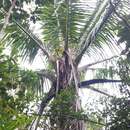en
names in breadcrumbs


The Forest Coconut, Voanioala gerondii, is a slow-growing palm from the family Arecaceae, discovered and described in 1989 as the only species in genus Voaniala.Endemic to the Northeast of Madagascar, it currently occurs only in three separate locations in swampy valleys and on low hills (up to an elevation of 450 meters) in palm dominated rain forest around the Bay of Antongil, largely in Parc National de Masola. The Forest Coconut is a massive palm that grows to 15-20 meters tall. The crown is composed of 15-20 bracts, each about 5 meters long.Up to 60 flower stalks develop at a time, and bear mature fruit that is about 8X5 cm, and red-brown when mature.Fruit accumulate under the tree, indicating that animals or birds that once acted as dispersal agents may have become extinct.The thick, hard endocarp suggests that animals involved in dispersal would need special adaptation for opening the fruit, such as the extinct elephant bird (Aepyornis).The fruit are attractive to illegal seed collectors, and the edible palm heart is also desirable; harvesting of this species in addition to habitat loss to agriculture and logging has reduced the number of mature individuals to about 15-30 trees total.The IUCN recognizes V. gerondii as critically endangered, and it is included as one of the world’s 100 most endangered species in a report submitted by the IUCN and the Zoological Society of London in 2012.
Study of seedlings germinated from isotypes held in the Kew Living Collections Department show that V. gerondii has a mitotic index much larger than other palms and shows rapid root growth, although seedlings are reported to grow very slowly.Their seeds are banned from export; few individuals are cultivated outside of Madagascar.V. gerondii is polypoid (uncommon for palms) and has a chromosome count far larger than most palms (with a diploid number more than 550, as compared to other polyploid palms reported between 2n=64-200).Its chromosomal number may be one of the highest known chromosome numbers for angiosperms in general.It is thought to be closely related to Jubaeopsis caffra, a diploid palm native to the Eastern Cape of South Africa, thus may have diverged from a polyploid ancestor before the separation of Madagascar from the African continent.The Forest Coconut also has a close relationship with the modern coconut, Cocos nucifera.
(Dransfield 1989; Dransfield and Beentje 1995; Dransfield et al. 2006; Dransfield and Rakotoarinivo 2011; Johnson 1989; Palmapedia.net 2012; Rakotoarinivo and Dransfield 2012)
Voanioala gerardii, commonly known as the forest coconut, is a species of flowering plant in the family Arecaceae. It is a relative of the coconut, and is generally regarded as monotypic within the genus Voanioala. However, a team of geneticists headed by Bee F. Gunn found sufficient genetic variation within Voanioala to constitute at least two and possibly four cryptospecies.[2] Voanioala is endemic to Madagascar, and is threatened by habitat loss. Voanioala is harvested for its edible seeds and palm heart. It is estimated that there are fewer than fifteen mature trees remaining.[1]
The forest coconut is a Madagascan tree that can reach 15–20 meters high in the wild. It is supported by a strong root base, and its leaves sprout from the crown. Voanioala can reach up to 5 meters in height. The leaflets are waxy, green, and stiff, and seventy of them can grow from each side of a leaf. The fruit grows in groups at the crown with a thick reddish-brown color. Each seed is up to 2.8 inches (7 cm) long and 1.5 inches (3.5 cm) thick and is longitudinally grooved.[3] A scientifically remarkable trait is that each cell has about 600 chromosomes, which is extraordinary for a monocotyledon.[4]
Voanioala gerardii is endemic to Madagascar, and is found in only the Bay of Antongil of the Masoala Peninsula, in the northeastern area of the island. It is extremely rare.[1][4]
The forest coconut is found in the bottom of swampy valleys, as well as slopes in rainforests[4] at an elevation of 200–450 meters above sea level.[5]
Voanioala gerardii is critically endangered because of its scarcity. Only 10-15 trees are found. They are cut down for their edible palm hearts, and their seeds are used for market trade. They are also rare because of its poor dispersal of seeds. Habitat loss through agricultural logging threatens forest coconuts as well.[1] The national park in Masoala Peninsula protects the forest coconuts on its property, and its future depends greatly on the effort of the national park.[4] Its population is currently decreasing.[1]
Voanioala gerardii, commonly known as the forest coconut, is a species of flowering plant in the family Arecaceae. It is a relative of the coconut, and is generally regarded as monotypic within the genus Voanioala. However, a team of geneticists headed by Bee F. Gunn found sufficient genetic variation within Voanioala to constitute at least two and possibly four cryptospecies. Voanioala is endemic to Madagascar, and is threatened by habitat loss. Voanioala is harvested for its edible seeds and palm heart. It is estimated that there are fewer than fifteen mature trees remaining.